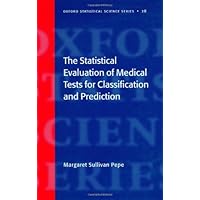
Average Reviews:

(More customer reviews)With the increase in cancer trials both in medical research and the pharmaceutical industry, medical diagnostic tests including medical imaging evaluations are being used more and more. There is a need for adjudication when radiologists disagree on a diagnosis and some standard statistical measures from other fields are finding new application.
This book provides a thorough background on the subject, the methodology and the applications. It is very clearly written and not overly technical. The methodology is the classical frequentist approach to statistical inference. Recently, Lyle Broemeling has published a book on this topic that takes exclusively the Bayesian approach and explains the Bayesian approach for those who are not acquainted with it. When dealing with predictions based on evolving data the Bayesian approach might be more natural. This would be the case in a clinical trial where the data is reviewed sequentially.
A particularly important part of diagnostic accuracy analysis is the area under the ROC curve. Pepe does an excellent job of covering that topic. This text is referenced often in Broemeling's book since it provides an excellent explanation of the same topics using the frequentist approach that he covers with the Bayesian approach.
Click Here to see more reviews about: The Statistical Evaluation of Medical Tests for Classification and Prediction (Oxford Statistical Science Series)
This book describes statistical concepts and techniques for evaluating medical diagnostic tests and biomarkers for detecting disease. More generally, the techniques pertain to the statistical classification problem for predicting a dichotomous outcome. Measures for quantifying test accuracy are described including sensitivity, specificity, predictive values, diagnostic likelihood ratios and the Receiver Operating Characteristic Curve that is commonly used for continuous and ordinal valued tests. Statistical procedures are presented for estimating and comparing them. Regression frameworks for assessing factors that influence test accuracy and for comparing tests while adjusting for such factors are presented. This book presents many worked examples of real data and should be of interest to practicing statisticians or quantitative researchers involved in the development of tests for classification or prediction in medicine.

No comments:
Post a Comment